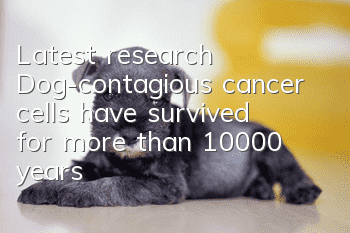Latest research: Dog-contagious cancer cells have survived for more than 10,000 years

Scientists have discovered a type of contagious cancer cell in dogs that has survived for nearly 11,000 years, making it the longest-lived cancer cell at present. Puppies like to sniff and lick everywhere, but this can easily lead to disease. One of the most common and highly contagious types is genital tract tumors, which are spread through mating and licking sick dogs.
When did this contagious cancer begin to spread among dogs? Scientists looked for answers from two infected puppies. They sequenced the genes of their cancer cells and traced their origins. They found that the cancer cells in the two dogs were originally It has survived for more than 11,000 years. Believed to be from a Mesolithic sled dog-like dog, it is also believed to be the first dog to suffer from reproductive tract tumors.
Unlike ordinary cancers, the cancer cells in this dog did not disappear with the death of the host. Instead, they spread to other dogs through dog mating, and then from one group of dogs to another group of dogs. Hundred. During this period, it experienced nearly 2 million genetic mutations. It was originally only spread among a single dog, and then began to widely infect dogs around the world nearly 500 years ago.
To this day, it has been found in two puppies living in Brazil and Australia, making it the "most long-standing" cancer cell discovered so far.
Scientists can even sequence the cancer cell genes of these two dogs to infer that the first generation of infected dogs came from an inbred group of dogs and had gray-brown or black straight short hair, but they were unable to determine its gender.
Reproductive tract tumors can also occur in dogs’ lymph nodes and eyes. They are one of the two known contagious cancers. The other is a facial tumor on the Australian Tasmanian devil, which is transmitted through bites.
Although there are not many cancers that are contagious, experts remind that cancer cells in humans or other animals may become diseased. This study is helping to understand the relationship between cancer cell mutations and infectivity.
- How to treat urinary tract stones in dogs? Dogs may need surgery!
- What should I do if my dog has no milk? The owner should check quickly and don’t let the puppies starve to death.
- Dog’s anal gland odor, please note that this is a sign of your dog’s health!
- How to make your dog like to eat dog food Four ways to make your dog fall in love with dog food
- Can dogs digest peach pits if they eat them? Can dogs digest peach pits if they accidentally eat them?
- How to protect your dog’s food? Teach you tips on training your dog
- Why do dogs defecate everywhere? How can dogs stop defecating everywhere?
- What should I do if my dog has lupus? Immune system diseases should not be underestimated
- If your dog's hair is cut and the skin is cut, the flesh is exposed. If the dog's hair is accidentally cut and the skin is cut, it must be disinfected immediately.
- Do dogs need deworming in summer? What should you pay attention to when raising dogs in summer?



